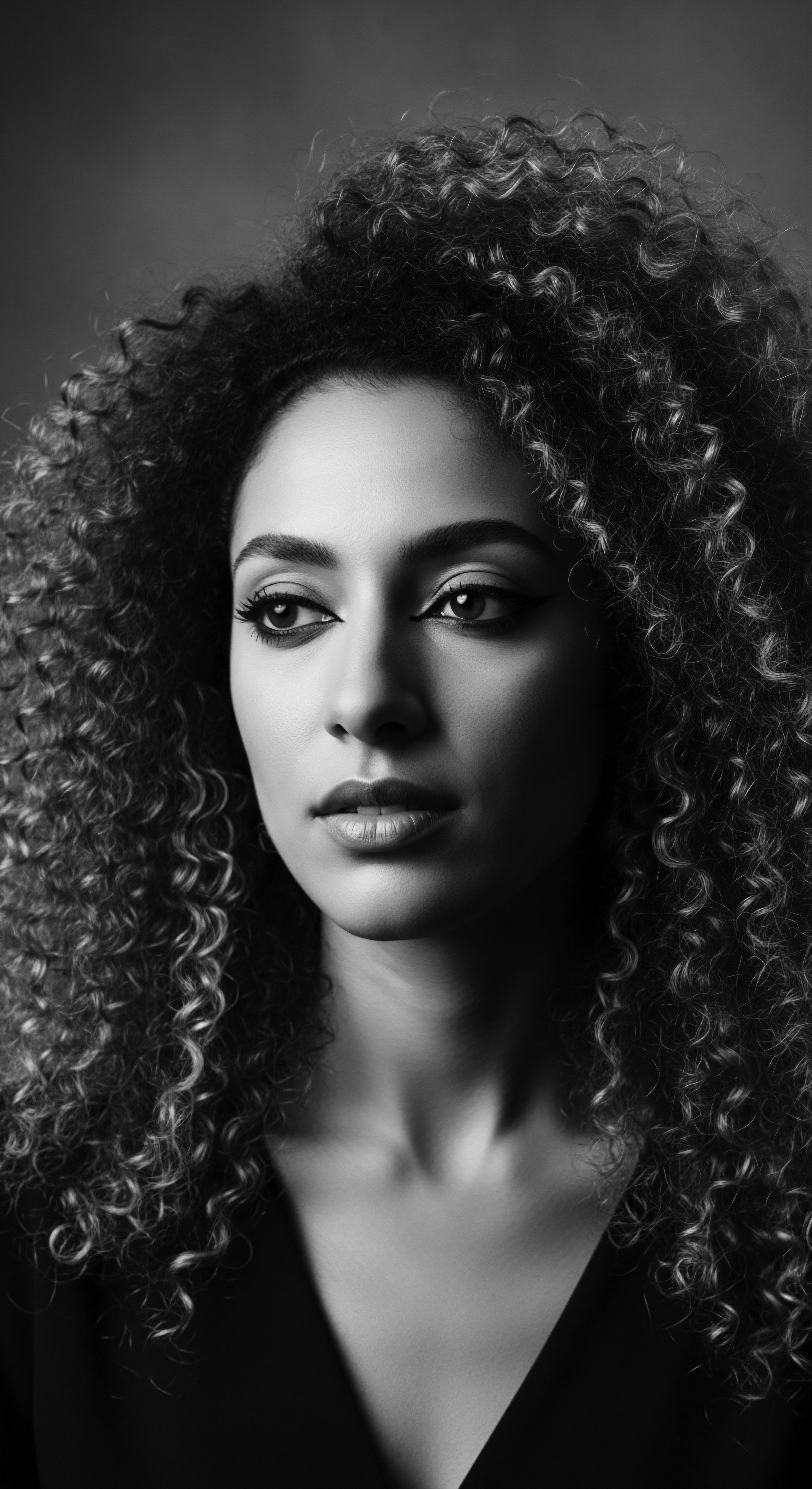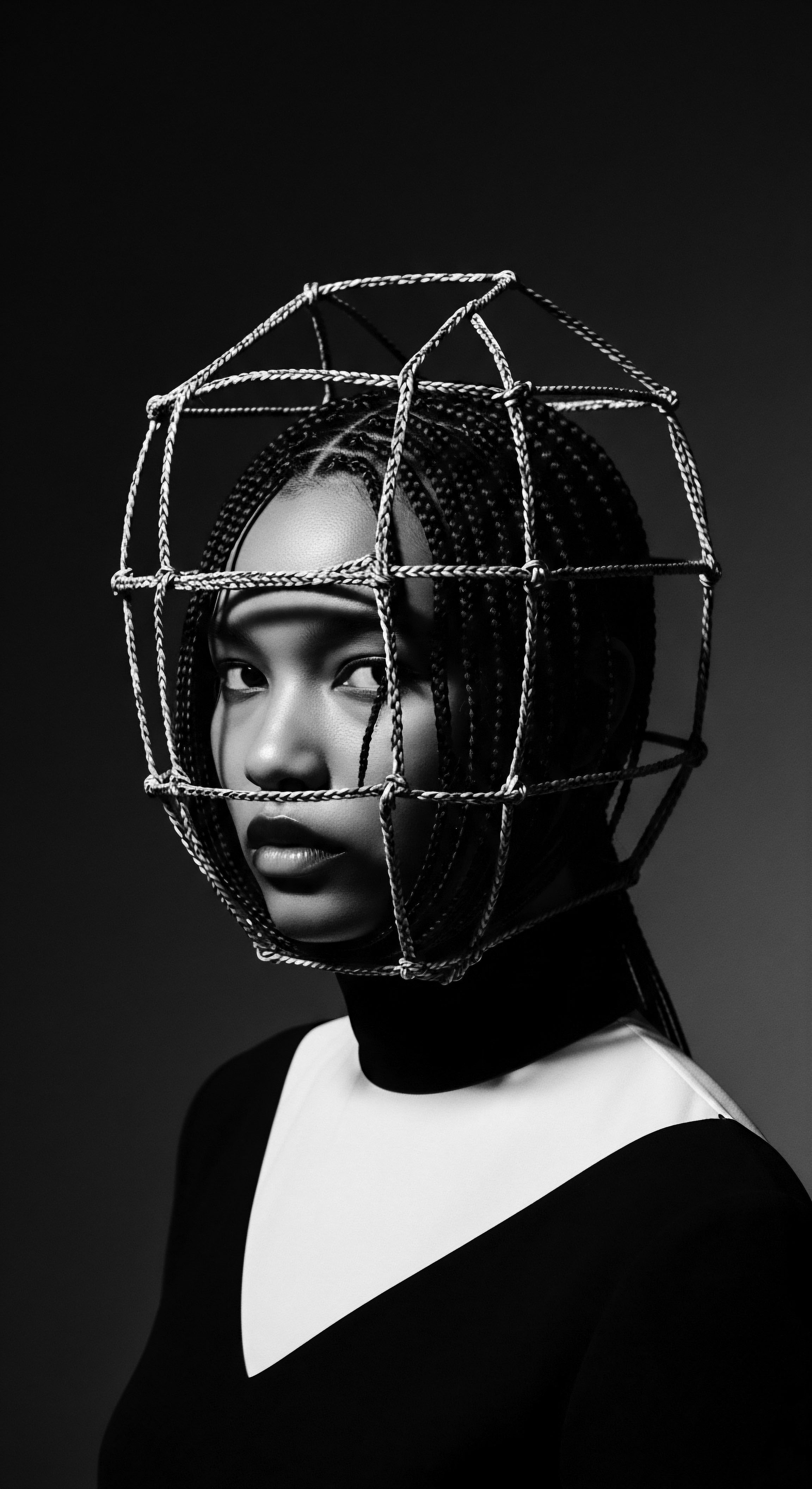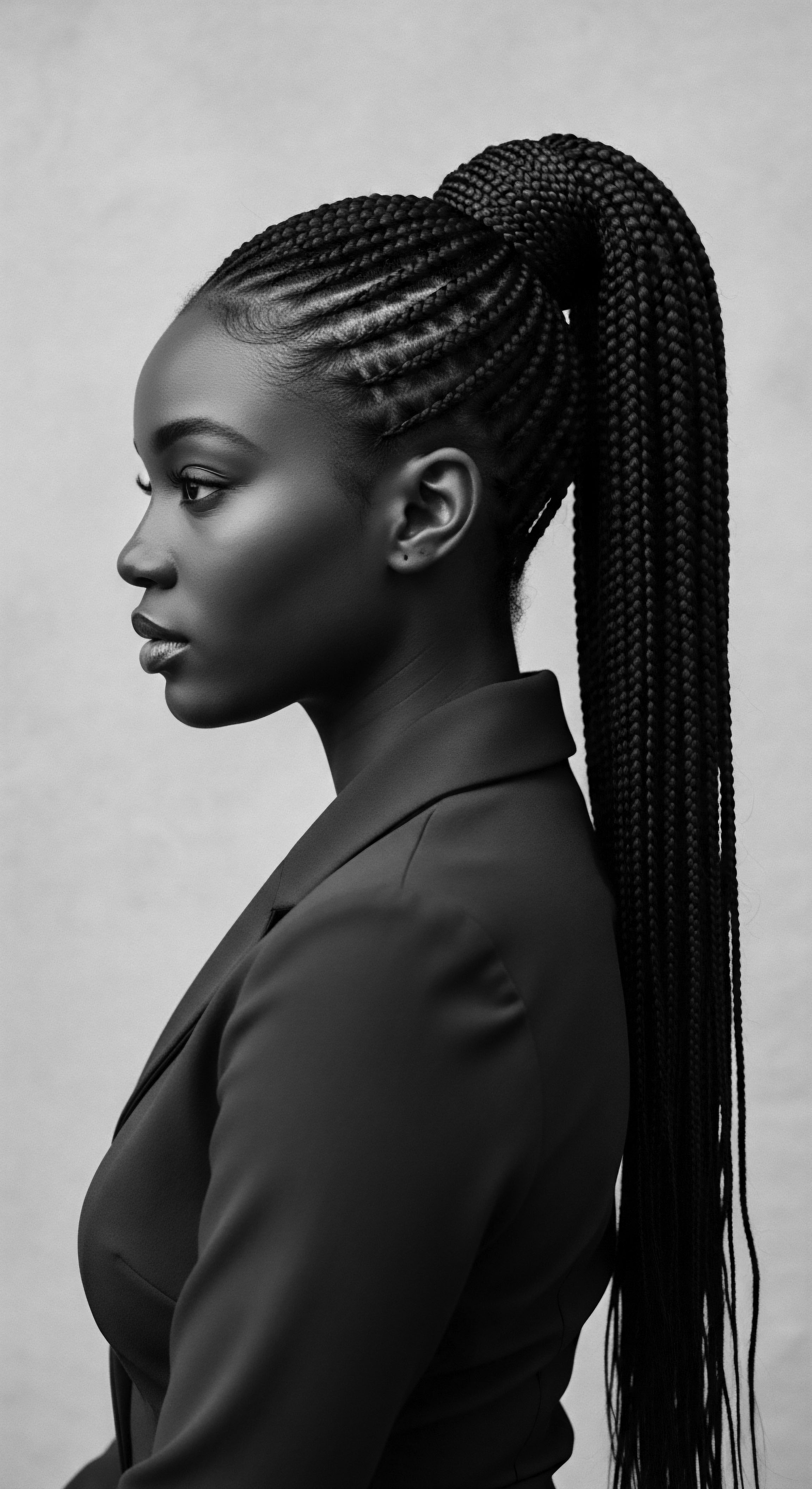
Roots
There exists a profound, unspoken language carried within the coils and curves of textured hair. It is a language whispered through generations, a silent saga etched into each strand, speaking of resilience, creativity, and the unwavering spirit of those who have worn it. For Black and mixed-race communities, hair extends beyond biology; it represents a living archive, a sacred lineage, and a testament to heritage that has guided cultural narratives across vast expanses of time and geography.

What Ancient Science Reveals About Hair’s Elemental Structure?
From the microscopic realm, we comprehend textured hair as an architectural marvel. Its elliptical or flattened cross-section, unlike the more circular shape of straight strands, contributes to its remarkable curl patterns. The way the keratin proteins arrange themselves within the hair shaft, particularly the distribution of disulfide bonds, influences the helix’s tight turns and spring-like elasticity.
This inherent structure, a biological blueprint passed down through ancestral lines, determined not just appearance but also how care rituals developed over millennia. Ancient communities, without the benefit of modern microscopy, understood these variations through intuitive knowing and observation, recognizing the unique needs of each curl type long before scientific classification systems came into being.
Textured hair, a biological masterpiece, carries the ancestral blueprints of resilience and has long served as a profound repository for cultural identity.
The earliest human communities regarded hair as a vital aspect of being, a conduit to spiritual realms and a public declaration of one’s place within society. Consider the deep past of African civilizations. Here, hair was meticulously styled not just for beauty, but as a complex system of communication.
A person’s hairstyle could signal their age, marital status, social standing, religious beliefs, or even their tribal affiliation (Afriklens, 2024; The Kurl Kitchen, 2024; Afrika.com). For instance, specific coiffures of the Himba tribe in Namibia, adorned with ochre paste, announced stages of life, while the elaborate arrangements among the Yoruba people of Nigeria signified community roles (Afriklens, 2024; Afrika.com).

How Did Hair Patterns Conceal Pathways to Freedom?
The enduring power of textured hair as a guide for cultural stories became starkly evident during periods of immense suffering and resistance. During the transatlantic slave trade, when individuals were forcibly removed from their homelands and their heads often shaved in a deliberate act of dehumanization, hair became a symbol of defiant continuity (BLAM UK CIC, 2022; Noma Sana, 2024). In an astonishing display of human ingenuity and unwavering spirit, enslaved Africans, particularly in places like Colombia and later within the broader African diaspora, transformed their cornrows into secret communication systems. These seemingly decorative patterns were, in fact, intricate maps to freedom, encoding escape routes, waterways, and safe havens for those seeking liberation (Ancient Origins, 2022; childish mane llc, 2023; Odele Beauty, 2024).
One striking example from oral tradition speaks of a legendary figure, Benkos Biohó, an escaped enslaved African who founded San Basilio de Palenque, the first free village in the Americas. His story includes the strategic use of cornrows to convey messages and escape plans (Ancient Origins, 2022; ArcGIS StoryMaps, 2023). Specific patterns held distinct meanings:
- Departes ❉ A hairstyle with thick braids tied into buns on top signaled plans for departure.
- Worm ❉ A single braid shaped like a worm could represent a river or a hidden pathway.
- Mountain ❉ A Bantu knot might indicate the presence of a mountain or a significant landmark.
- North Star ❉ Three straight cornrows from forehead to nape of neck could guide escapees north (childish mane llc, 2023).
Beyond geographical directions, these styles also concealed precious items, such as rice grains or seeds, offering nourishment for journeys and the promise of new beginnings in liberated settlements (The Art of Healing, 2022; Beds SU, 2022; ArcGIS StoryMaps, 2023; Odele Beauty, 2024). This remarkable historical truth affirms textured hair’s role as more than mere adornment; it served as a living blueprint of survival, a silent yet potent guide for cultural preservation and communal defiance.
| Era/Context Pre-Colonial Africa |
| Primary Cultural Guidance Social hierarchy, age, marital status, spirituality, tribal affiliation, community roles, vitality, prosperity |
| Form of Expression in Hair Elaborate braids, coiffures, dreadlocks, specific adornments (ochre, beads) |
| Era/Context Enslavement Era |
| Primary Cultural Guidance Survival, coded communication, escape routes, hidden provisions, defiance, cultural continuity |
| Form of Expression in Hair Cornrows as maps, specific patterns denoting routes, hidden seeds/fragments within styles |
| Era/Context Textured hair’s ability to transmit vital information adapted to profound shifts in cultural context. |

Ritual
The very act of caring for and styling textured hair has always constituted a profound ritual, a sacred practice passed down through family lines, often from elder to younger. This continuity of method, technique, and shared wisdom is a central element of heritage. These rituals, far from being superficial acts of beautification, served as moments of profound connection, storytelling, and the reinforcement of cultural bonds. Each stroke of a comb, each part created, each strand twisted, speaks to a lineage of care, a legacy of ancestral hands nurturing the coils and kinks of their kin.

How Do Styling Practices Echo Ancestral Wisdom?
Traditional styling for textured hair is a testament to ingenuity born from necessity and a deep connection to natural materials. Before the advent of modern products, African communities relied on local botanicals—plant oils, butters, clays, and herbs—to nourish and protect hair. These ingredients were selected for their inherent properties, understood through generations of observation and experimentation. The concept of “protective styling,” so widely discussed today, has ancient roots.
Styles like cornrows, Bantu knots, and various forms of braiding safeguarded strands from environmental aggressors, minimized manipulation, and promoted length retention (Afriklens, 2024; BLAM UK CIC, 2022). These were not simply hairstyles; they were ingenious methods of hair preservation, allowing communities to maintain healthy hair despite challenging conditions.
The social aspect of hair styling further reinforced its cultural guiding role. Hair sessions were communal, often taking place under a gathering tree or in a quiet courtyard. These were spaces where stories were exchanged, wisdom imparted, and community ties strengthened (Afrika.com).
Young hands learned from older, mimicking the precise movements, internalizing the patience and reverence required. This shared experience solidified a collective identity, with hair becoming a tangible marker of belonging.
Hair care rituals, rooted in communal practices and ancestral plant knowledge, transmit heritage through the tender touch of shared tradition.
Consider the tools themselves. Early combs, crafted from wood or bone, were designed to navigate the unique structure of coiled hair with minimal breakage. Adornments, too, carried specific meanings.
Shells, beads, and precious metals incorporated into styles were not merely decorative; they could signify wealth, social status, or even spiritual protection (Afriklens, 2024). The transformation of hair through these rituals was thus a complete experience, engaging the physical, social, and spiritual dimensions of life.
- Palm Oil ❉ Valued for its conditioning properties, often incorporated into traditional hair concoctions.
- Shea Butter ❉ A staple for moisture and sealing, used for centuries to soften and protect hair.
- Baobab Oil ❉ Rich in vitamins, applied for strength and shine, drawing from the ancient “tree of life.”
This heritage of care continues to resonate. The modern natural hair movement, a powerful contemporary cultural story, draws direct lineage from these ancestral practices. It champions the embrace of natural textures, rejecting external pressures for conformity, and advocating for gentle, nourishing routines (Noma Sana, 2024; The Kurl Kitchen, 2024).

Relay
The journey of textured hair through history demonstrates an ongoing relay of cultural significance, a continuous handing over of meaning from one generation to the next. This living legacy constantly adapts, yet remains anchored by its deep roots in heritage. It is a testament to human spirit, how hair, seemingly a biological feature, has become a dynamic emblem of identity, protest, and aspiration, influencing societal norms and legislative actions.

What Role Does Hair Play in Voicing Identity and Shaping Society?
As communities of color navigated complex global landscapes shaped by colonialism and systemic oppression, textured hair emerged as a prominent voice in their cultural stories. During periods when Eurocentric beauty ideals were enforced, leading to practices such as hair straightening (Noma Sana, 2024), the act of wearing natural hair became a powerful statement of resistance. The 1960s and 1970s marked a pivotal moment, with the rise of the Civil Rights and Black Power movements.
The Afro hairstyle, a voluminous crown of coils, stood as an unapologetic rejection of imposed standards and a bold assertion of Black pride and identity (Afriklens, 2024; BLAM UK CIC, 2022; Noma Sana, 2024; The Kurl Kitchen, 2024). Figures like Angela Davis, with her iconic Afro, symbolized this cultural revolution, making hair a political statement (Afriklens, 2024; The Kurl Kitchen, 2024).
This generational shift, rooted in the conscious reclamation of ancestral aesthetics, directly guided new cultural stories of self-acceptance and empowerment. The continuing journey led to legislative movements aimed at protecting the right to wear natural hair without facing discrimination. A significant stride in this ongoing cultural narrative is the CROWN Act . This legislation, an acronym for “Creating a Respectful and Open World for Natural Hair,” addresses the denial of opportunities based on hair texture or protective styles like braids, locs, twists, and knots (McLane Middleton, 2023; Nu Origins Magazine, 2023; Law Office of Bryan Fagan, 2023).
The Act’s emergence in 2019, beginning in California and subsequently adopted by many other states, reflects a societal reckoning with historical prejudices (McLane Middleton, 2023; Nu Origins Magazine, 2023). It legally affirms the cultural significance of Black hair and aims to dismantle long-held biases in workplaces and educational settings (Law Office of Bryan Fagan, 2023; McLane Middleton, 2023). A Michigan State University study found that 80% of Black women felt pressure to straighten their hair to fit into professional environments, a figure that underscores the necessity of such protective legislation (McLane Middleton, 2023).
| Historical Period 1960s-1970s Civil Rights Era |
| Cultural Story Guided Black pride, rejection of Eurocentric norms |
| Expression/Action The Afro hairstyle, natural hair movement |
| Historical Period Contemporary Era (Post-2019) |
| Cultural Story Guided Anti-discrimination, cultural affirmation, legal equity |
| Expression/Action CROWN Act legislation, advocacy for inclusive hair policies |
| Historical Period Hair continues its guiding role, transforming from a symbol of personal protest into a catalyst for institutional change. |

How Do Modern Wellness Practices Intersect with Ancient Wisdom?
The contemporary wellness movement, particularly within textured hair care, increasingly acknowledges its ancestral lineage. This connection brings scientific understanding into dialogue with time-honored practices. The search for health and vitality in hair now often looks back to ingredients and techniques used by ancestors, examining their efficacy through a modern scientific lens. For example, the use of natural oils such as coconut, castor, and olive for conditioning and scalp health, deeply embedded in many traditional African and diasporic hair care regimens, finds validation in current trichology which recognizes their emollient and protective qualities.
This melding of ancient and modern helps cultivate hair care routines that respect the hair’s inherent biology while honoring its cultural past. It is a path of discovery, where the wisdom of the past informs the choices of the present, ensuring that the legacy of textured hair continues to guide stories of holistic well-being and genuine self-regard. The journey from elemental biology to a powerful cultural emblem truly showcases textured hair’s continuous relay of meaning, demonstrating its enduring capacity to guide and shape identity.

Reflection
Textured hair, in its myriad forms, stands as a profound testament to memory and continuous cultural guidance. It is more than an adornment; it functions as a living chronicle, a physical manifestation of heritage carried forward through human lives. From the earliest human societies, where strands spoke of status and spiritual connection, to the harrowing passages of enslavement, where patterns became coded maps for freedom, and further still, to modern movements championing identity and legal protection, textured hair has consistently guided cultural stories.
The lessons embedded within these coils and kinks resonate with an unwavering spirit of adaptation and resilience. Each strand holds the echoes of ancestral hands, the whispered stories of community gatherings, the defiant spirit of protest, and the radiant assertion of self-acceptance. This living archive, continually reinterpreted yet deeply rooted, ensures that the unique beauty and complex history of Black and mixed-race hair will continue to shape narratives for all who choose to listen, to learn, and to honor its legacy. The ‘Soul of a Strand’ truly lies in its enduring capacity to connect us to a profound, living past, forever influencing the unfolding human narrative.

References
- Afriklens. (2024). African Hairstyles ❉ Cultural Significance and Legacy.
- Ancient Origins. (2022). African Slaves Used Braids to Communicate Escape Routes in Colombia.
- Beds SU. (2022). Black History Month 2022 ❉ The History Behind Cornrows.
- BLAM UK CIC. (2022). The History of Black Hair.
- childish mane llc. (2023). ROAD TO FREEDOM ❉ How Enslaved Africans in America Used Hair Styles to Map Escape Routes.
- Law Office of Bryan Fagan. (2023). Crowning Glory ❉ Understanding the Impact of The CROWN Act.
- McLane Middleton. (2023). Understanding Hair Discrimination and the CROWN Act.
- Noma Sana. (2024). The History of Straightening Afro Hair ❉ Culture, Trends & Identity.
- Nu Origins Magazine. (2023). “Crowning Glory ❉ The Impact of the Crown Act on Hair Discrimination”.
- Odele Beauty. (2024). A History Of Hair Braiding.
- The Art of Healing. (2022). A Nostalgic Ode to Black Hair Braiding.
- The Kurl Kitchen. (2024). The Cultural Significance Of Natural Hair In Different Communities.
- Afrika.com. A History Of African Women’s Hairstyles.
- ArcGIS StoryMaps. (2023). Hair Mapping.
